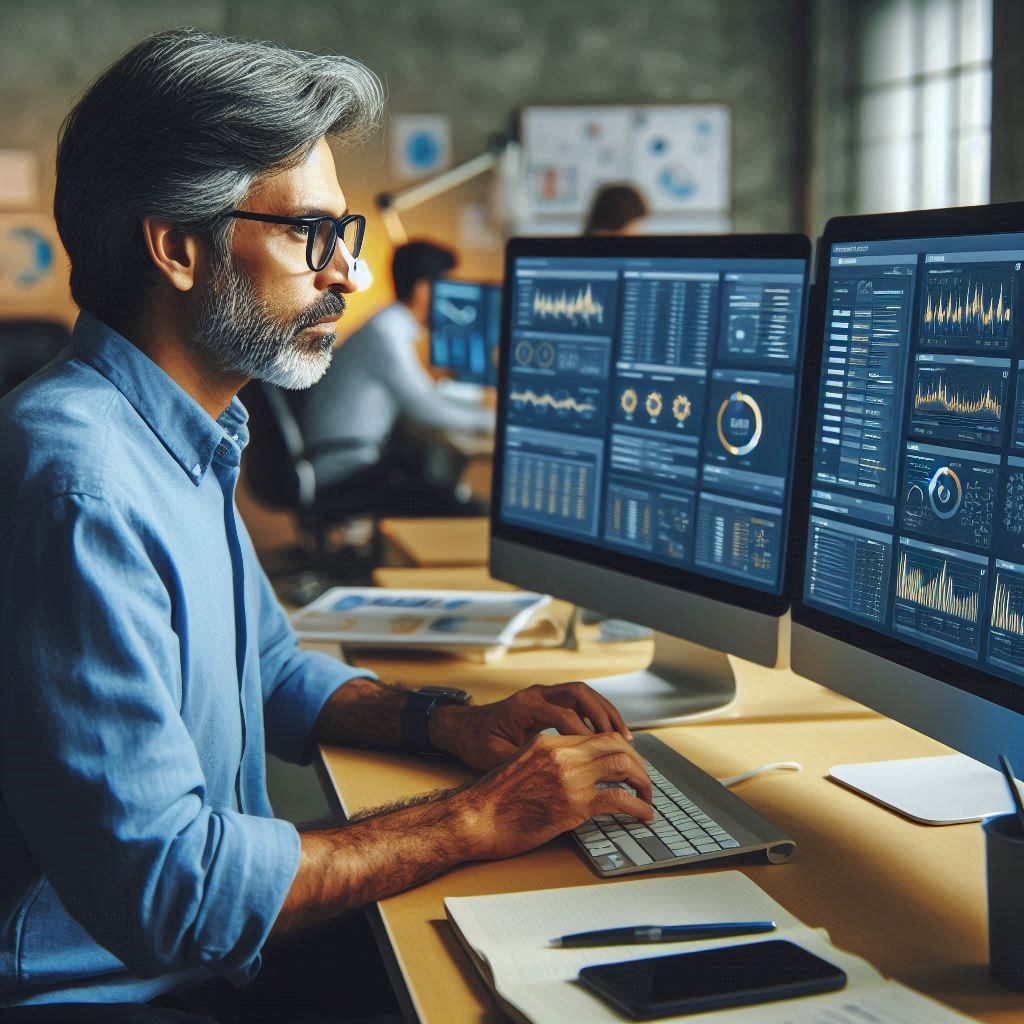Introduction
Let’s explore life with IoT devices.
Imagine a world where over 50 billion devices connect seamlessly by 2030.
This is the reality of the Internet of Things (IoT).
In today’s rapidly advancing technological landscape, IoT devices are everywhere.
They transform our homes, workplaces, and even our daily routines.
Striking Statistics
- Over 30 billion IoT devices existed in 2020.
- By 2025, the global IoT market will reach $1.1 trillion.
- Smart home device sales increased by 45% in the last two years.
These numbers show how deeply IoT devices integrate into our lives.
They reshape how we interact with our environment.
The IoT Revolution
IoT devices bring unparalleled convenience.
They allow us to control home appliances remotely.
You can adjust your thermostat from your phone.
Your smart fridge can remind you when groceries run low.
These are just a few examples of IoT’s impact on personal life.
Professionally, IoT devices enhance efficiency.
Businesses use smart sensors to monitor equipment.
This helps prevent breakdowns and reduces maintenance costs.
Innovative Tech Solutions, Tailored for You
Our leading tech firm crafts custom software, web & mobile apps, designed with your unique needs in mind. Elevate your business with cutting-edge solutions no one else can offer.
Start NowIn offices, IoT devices optimize lighting and heating.
This improves energy efficiency and reduces costs.
Enhancing Connectivity
IoT devices create a network of interconnected gadgets.
This network enhances connectivity.
Your smartphone communicates with your smartwatch.
Your office computer links with your printer.
This connectivity streamlines tasks and improves productivity.
Personal Life Transformation
- Smart Homes: IoT devices make homes more efficient and secure.
- Health Monitoring: Wearables track health metrics in real-time.
- Automated Assistance: Voice assistants provide instant information and control over various devices.
Professional Life Transformation
- Efficient Workspaces: IoT devices optimize office environments.
- Predictive Maintenance: Sensors monitor equipment health in real-time.
- Enhanced Customer Experiences: Retailers use IoT for personalized shopping experiences.
IoT devices revolutionize both personal and professional life.
They bring unparalleled convenience, efficiency, and connectivity.
As we embrace IoT, we step into a more connected and efficient world.
The future promises even more innovations that will continue to transform our daily lives.
Understanding IoT Devices
Definition of IoT (Internet of Things)
The Internet of Things (IoT) refers to a network of interconnected devices.
These devices collect and exchange data.
They enhance everyday life through automation and connectivity.
IoT devices range from household items to industrial machinery.
Key Components of IoT
IoT devices rely on three main components:
- Sensors: These devices collect data from their environment.
- Connectivity: This allows devices to communicate with each other.
- Data Processing: This analyzes the collected data to make decisions or trigger actions.
Brief History and Evolution
The concept of IoT dates back to the early 1980s.
A Coca-Cola machine at Carnegie Mellon University became the first internet-connected appliance.
Researchers used it to check the availability of cold drinks. This marked the beginning of IoT.
In the 1990s, the term “Internet of Things” was coined by Kevin Ashton.
He envisioned a system where physical objects connected to the internet.
The early 2000s saw advancements in wireless technology.
This spurred the growth of IoT devices.
Seamless API Connectivity for Next-Level Integration
Unlock limitless possibilities by connecting your systems with a custom API built to perform flawlessly. Stand apart with our solutions that others simply can’t offer.
Get StartedThe development of IPv6 in the late 2000s further accelerated IoT adoption.
IPv6 provided a virtually unlimited number of IP addresses.
This allowed billions of devices to connect to the internet.
Today, IoT devices permeate various industries, transforming operations and lifestyles.
Current Market Landscape
The IoT market is booming. Over 30 billion IoT devices existed globally in 2020.
By 2025, this number will surpass 75 billion.
This growth highlights the increasing reliance on IoT technology.
Several factors drive IoT adoption:
- Advancements in Connectivity: 5G networks enhance the speed and reliability of IoT connections.
- Affordable Sensors: Reduced costs make IoT devices accessible to a wider audience.
- Increased Data Processing Power: Enhanced computing capabilities enable real-time data analysis.
Widespread Adoption of IoT Devices
IoT devices are ubiquitous in many sectors.
In homes, smart thermostats and lighting systems improve energy efficiency.
Wearable fitness trackers monitor health metrics.
Smart speakers provide hands-free assistance.
In the industrial sector, IoT devices streamline operations.
Factories use sensors for predictive maintenance.
This reduces downtime and increases productivity.
Supply chains leverage IoT for real-time tracking.
This enhances inventory management and reduces losses.
Healthcare benefits significantly from IoT technology.
Remote monitoring devices allow patients to manage chronic conditions.
Hospitals use IoT to track equipment and streamline workflows.
This improves patient care and operational efficiency.
Retailers also embrace IoT for enhanced customer experiences.
Smart shelves monitor inventory levels.
Personalized marketing leverages data from connected devices.
Transform Business with Custom CRM & ERP Solutions
Elevate your operations with a CRM or ERP tailored for you. Let’s build the perfect solution that others can't replicate—crafted to match your business's needs like no other.
Get StartedThis increases customer satisfaction and sales.
Challenges and Opportunities
Despite its benefits, IoT faces several challenges.
Security remains a significant concern. IoT devices often lack robust security measures.
This makes them vulnerable to cyberattacks.
Ensuring data privacy is also critical. Manufacturers must prioritize security in device design.
Interoperability is another challenge. IoT devices from different manufacturers may not communicate effectively.
Standardization efforts aim to address this issue.
Collaboration between companies will enhance device compatibility.
The future of IoT holds immense potential.
Emerging technologies like artificial intelligence and edge computing will drive further innovation.
These advancements will unlock new applications and improve existing ones.
In fact, understanding IoT devices involves recognizing their components and history.
The current market landscape shows rapid growth and widespread adoption.
IoT devices transform various sectors, enhancing convenience and efficiency.
Overcoming challenges will pave the way for a more connected future.
Read: Smart Home Technologies for Everyday Life: Top Enhancements

IoT in Personal Life
Smart Homes
IoT devices transform homes into smart homes.
They offer unparalleled convenience and efficiency.
Smart thermostats allow users to control home temperatures remotely.
These devices learn user preferences and adjust settings automatically.
This results in significant energy savings.
Smart lighting systems adjust brightness based on occupancy.
They enhance convenience and save energy. Users can control lighting through their smartphones.
This allows for customized lighting scenes for different activities.
Tailored Tech Solutions to Drive Your Business Forward
Maximize your business potential with custom tech strategies. We deliver bespoke solutions that others can’t match, designed to solve your specific challenges with precision and impact.
Contact UsSecurity systems have become smarter with IoT.
Cameras, motion detectors, and smart locks provide enhanced security.
Users receive real-time alerts on their phones.
This allows for immediate action if any suspicious activity occurs.
Smart appliances are another innovation. Refrigerators can track food inventory.
They can suggest recipes based on available ingredients.
Washing machines can be scheduled to run during off-peak hours.
This saves on electricity costs and optimizes energy use.
Benefits of Smart Homes:
- Energy efficiency
- Enhanced security
- Convenience
Wearable Technology
Wearable technology has revolutionized personal health and fitness.
Smartwatches track daily activities like steps and calories burned.
They monitor heart rates and sleep patterns.
This helps users maintain a healthy lifestyle.
Fitness trackers offer detailed insights into physical activities.
They provide personalized fitness plans.
These plans are based on individual goals and performance.
Users receive real-time feedback and motivation.
Health monitors play a crucial role in managing chronic conditions.
Devices like glucose monitors track blood sugar levels continuously.
They send alerts if readings are abnormal.
This allows for timely intervention and better health management.
Benefits of Wearable Technology:
- Health tracking
- Personalized fitness plans
- Emergency alerts
Connected Vehicles
IoT has significantly impacted the automotive industry.
Connected vehicles offer advanced features that enhance driving experiences.
GPS navigation systems provide real-time traffic updates.
They suggest alternative routes to avoid congestion.
Smart infotainment systems connect to smartphones.
They offer hands-free control of music, calls, and messages.
This keeps drivers focused on the road and improves safety.
Advanced driver-assistance systems (ADAS) enhance vehicle safety.
Features like lane-keeping assist and automatic emergency braking prevent accidents.
These systems use sensors and cameras to monitor the vehicle’s surroundings.
Benefits of Connected Vehicles:
- Improved safety
- Better navigation
- Enhanced entertainment
Health and Wellness
IoT devices play a significant role in health and wellness.
Remote health monitoring systems track vital signs continuously.
They send data to healthcare providers in real-time.
This allows for early detection of potential health issues.
Smart medical devices assist in managing chronic conditions.
Insulin pumps deliver precise doses based on real-time glucose readings.
This improves diabetes management and patient outcomes.
Wearable ECG monitors detect irregular heartbeats.
They send alerts to users and healthcare providers.
This enables timely medical intervention and reduces the risk of complications.
Benefits of IoT in Health and Wellness:
- Continuous health monitoring
- Timely medical intervention
- Improved patient outcomes
IoT devices have a profound impact on personal life.
Smart homes, wearable technology, connected vehicles, and health devices offer numerous benefits.
They enhance convenience, improve health, and increase safety.
As IoT technology continues to evolve, it will further revolutionize personal life.
This will lead to more efficient, healthier, and safer living.
Read: What is Internet of Things (IoT)?
IoT in Professional Life
Smart Offices
These smart offices use IoT devices to create more efficient and comfortable work environments.
Smart lighting systems adjust brightness based on natural light and occupancy.
This saves energy and reduces costs.
Climate control systems maintain optimal temperatures.
They adjust settings based on occupancy and preferences.
This enhances employee comfort and productivity.
Occupancy sensors provide valuable data on workspace usage.
They help optimize space allocation and reduce unused areas.
This leads to better space management and cost savings.
Benefits of Smart Offices:
- Enhanced productivity
- Energy savings
- Optimized workspace usage
Industrial IoT (IIoT)
The industrial sector benefits significantly from IoT technology.
Predictive maintenance sensors monitor equipment health in real-time.
They detect potential issues before they cause breakdowns.
This reduces downtime and maintenance costs.
Automated machinery increases production efficiency.
IoT-enabled machines can perform complex tasks with high precision.
They reduce human error and improve product quality.
Supply chain trackers provide real-time visibility of goods.
They monitor inventory levels and track shipments.
This ensures timely deliveries and better inventory management.
Benefits of Industrial IoT:
- Increased operational efficiency
- Reduced downtime
- Better resource management
Healthcare Industry
IoT devices revolutionize the healthcare industry.
Remote patient monitoring systems track vital signs continuously.
They send data to healthcare providers in real-time.
This allows for early detection of potential health issues.
Smart diagnostic tools provide accurate and timely results.
They enhance diagnostic accuracy and speed up treatment decisions.
Connected medical records streamline patient data management.
They ensure quick access to patient histories and improve care coordination.
Benefits of IoT in Healthcare:
- Improved patient care
- Streamlined operations
- Real-time data access
Enhancing Patient Care
Remote monitoring devices enable continuous health tracking.
Patients with chronic conditions benefit from real-time monitoring.
Devices like glucose monitors and blood pressure cuffs send alerts if readings are abnormal.
This allows for timely medical intervention and better health outcomes.
Smart diagnostic tools enhance diagnostic accuracy.
Portable ultrasound devices and smart stethoscopes provide detailed insights.
They help doctors make informed decisions quickly.
Connected medical records improve patient data management.
They ensure seamless access to patient histories.
This enhances care coordination among different healthcare providers.
Benefits of Enhanced Patient Care:
- Continuous health tracking
- Timely medical intervention
- Improved health outcomes
Streamlining Operations
IoT devices streamline healthcare operations.
Smart inventory systems track medical supplies.
They ensure timely replenishment and reduce waste.
Automated administrative tasks free up staff time.
IoT-enabled devices manage scheduling, billing, and patient check-ins.
This reduces administrative burdens and enhances efficiency.
Connected devices improve hospital asset management.
They track the location and status of medical equipment.
This reduces equipment loss and ensures availability when needed.
Benefits of Streamlined Operations:
- Efficient supply management
- Reduced administrative burdens
- Better asset management
Real-Time Data Access
IoT devices provide real-time data access in healthcare.
Wearable devices and remote monitors send data instantly.
Healthcare providers receive up-to-date information on patient conditions.
This allows for prompt response and better decision-making.
Connected medical records ensure quick access to patient data.
Doctors can review patient histories and treatment plans instantly.
This enhances the quality of care and reduces delays.
Smart diagnostic tools provide immediate results.
This speeds up the diagnosis process and improves treatment outcomes.
Benefits of Real-Time Data Access:
- Up-to-date patient information
- Prompt medical response
- Improved treatment outcomes
IoT devices significantly impact professional life.
They enhance productivity and efficiency in smart offices.
Also, they increase operational efficiency in industrial sectors.
They improve patient care and streamline operations in healthcare.
The adoption of IoT technology will continue to revolutionize professional life, leading to more efficient and effective work environments.
Read: The Benefits and Applications of IoT
Challenges and Concerns
Security and Privacy
IoT devices present significant security and privacy challenges.
Data breaches are a major concern. Hackers can exploit vulnerabilities in IoT devices.
Unauthorized access to personal and sensitive data can occur.
Surveillance concerns arise when devices collect and share data without consent.
To address these issues, manufacturers must implement enhanced encryption.
This ensures data remains secure during transmission.
Robust security protocols are essential.
Regular software updates and patches protect devices from new threats.
User education plays a crucial role.
Users must understand the importance of securing their devices and data.
Issues:
- Data breaches
- Unauthorized access
- Surveillance concerns
Solutions:
- Enhanced encryption
- Robust security protocols
- User education
Interoperability
Interoperability remains a significant challenge for IoT devices.
Compatibility between different devices and platforms is often lacking.
This limits the seamless integration of various IoT systems.
Users face difficulties when devices from different manufacturers do not work together.
Standardization efforts are necessary to improve interoperability.
Developing common standards ensures compatibility across devices.
Open APIs allow different systems to communicate effectively.
Industry collaboration is essential. Manufacturers must work together to create interoperable solutions.
Issues:
- Compatibility between different IoT devices and platforms
Solutions:
- Standardization efforts
- Open APIs
- Industry collaboration
Cost and Accessibility
The high initial cost of IoT devices poses a barrier.
Many potential users find these devices expensive.
This limits the widespread adoption of IoT technology.
The digital divide exacerbates the problem.
Not everyone has equal access to IoT devices and services.
Technological advancements can help reduce costs.
As technology improves, production costs decrease.
This makes IoT devices more affordable. Government policies can support IoT adoption.
Subsidies and incentives can encourage the use of IoT technology.
Affordable alternatives must be developed. Low-cost devices can bridge the digital divide.
Issues:
- High initial costs
- Digital divide
Solutions:
- Technological advancements
- Government policies
- Affordable alternatives
Addressing Security and Privacy
Data breaches can have severe consequences.
Enhanced encryption protects data during transmission.
Robust security protocols ensure devices remain secure.
Regular software updates and patches are vital.
These updates address new vulnerabilities and threats.
Users must be educated about IoT security.
They need to understand how to protect their devices and data.
Manufacturers should provide clear guidelines.
This includes setting strong passwords and enabling security features.
Improving Interoperability
Interoperability enhances the user experience.
Standardization efforts ensure devices from different manufacturers work together.
Developing common standards is essential.
Open APIs facilitate communication between different systems.
Industry collaboration plays a critical role.
Manufacturers must work together to create interoperable solutions.
This cooperation benefits users and drives IoT adoption.
Making IoT Accessible
High costs limit IoT adoption. Technological advancements reduce production costs.
This makes devices more affordable. Government policies can support IoT adoption.
Subsidies and incentives encourage users to embrace IoT technology.
Affordable alternatives bridge the digital divide.
Low-cost devices ensure everyone benefits from IoT advancements.
This promotes inclusivity and widespread adoption.
In a nutshell, challenges and concerns surround the adoption of IoT devices.
Security and privacy issues require enhanced encryption and robust protocols.
Interoperability needs standardization efforts and industry collaboration.
High costs and the digital divide demand technological advancements and affordable alternatives.
Addressing these challenges will ensure the continued growth and success of IoT technology.
The future of IoT depends on overcoming these obstacles to create a more connected and efficient world.
Read: The Impact of the Internet of Things (IoT) on Our Lives and Work

The Future of IoT
Emerging Trends
The future of IoT promises exciting advancements and transformative changes.
Key technologies are driving this evolution.
5G connectivity will revolutionize IoT by providing faster, more reliable connections.
This will enable real-time data transmission and reduce latency.
Artificial Intelligence (AI) integration will enhance IoT capabilities.
AI can analyze vast amounts of data from IoT devices.
It can identify patterns, predict outcomes, and automate processes.
This will make IoT systems smarter and more efficient.
Edge computing is another emerging trend.
It processes data closer to the source, reducing the need for centralized data processing.
This decreases latency and increases efficiency.
Edge computing will enable real-time data analysis and decision-making.
Technologies:
- 5G connectivity
- AI integration
- Edge computing
Innovations
Several innovations will shape the future of IoT.
Autonomous vehicles will become more prevalent.
These vehicles rely on IoT for navigation, traffic updates, and safety features.
They will transform transportation, reducing accidents and improving efficiency.
Smart cities will leverage IoT to enhance urban living.
IoT-enabled infrastructure will improve traffic management, waste disposal, and energy usage.
Smart sensors will monitor air quality, water levels, and public safety.
This will create more sustainable and livable cities.
Advanced healthcare solutions will emerge.
IoT devices will enable remote surgery, personalized medicine, and real-time health monitoring.
Smart medical devices will provide continuous care and improve patient outcomes.
This will revolutionize the healthcare industry.
Innovations:
- Autonomous vehicles
- Smart cities
- Advanced healthcare solutions
Predictions
The IoT market will continue to grow rapidly.
By 2025, there will be over 75 billion IoT devices globally.
This growth will drive significant changes across various industries and society.
In the manufacturing sector, IoT will enhance productivity and efficiency.
Smart factories will use IoT for real-time monitoring and predictive maintenance.
This will reduce downtime and improve product quality.
The retail industry will leverage IoT for personalized customer experiences.
Smart shelves, inventory management systems, and data analytics will optimize operations.
Retailers will provide tailored recommendations and improve customer satisfaction.
In agriculture, IoT will revolutionize farming practices.
Smart sensors will monitor soil conditions, weather patterns, and crop health.
Farmers will make data-driven decisions, increasing yield and reducing resource usage.
The energy sector will benefit from IoT-enabled smart grids.
These grids will optimize energy distribution, reduce wastage, and integrate renewable energy sources.
Consumers will have better control over their energy usage and costs.
Growth Projections:
- Over 75 billion IoT devices by 2025
Potential Impacts on Industries:
- Enhanced productivity in manufacturing
- Personalized customer experiences in retail
- Data-driven farming practices in agriculture
- Optimized energy distribution in the energy sector
Societal Changes
IoT will bring significant societal changes.
Smart homes and cities will improve living standards.
Enhanced healthcare will increase life expectancy and quality of life.
IoT will create new job opportunities and drive economic growth.
However, challenges will also arise. Data privacy and security concerns will need to be addressed.
Interoperability between different IoT devices and platforms will require standardization efforts.
Ensuring equitable access to IoT technology will be crucial to avoid a digital divide.
Societal Changes:
- Improved living standards
- Increased life expectancy and quality of life
- New job opportunities and economic growth
The future of IoT is bright and transformative.
Emerging technologies like 5G, AI, and edge computing will drive innovation.
Autonomous vehicles, smart cities, and advanced healthcare solutions will become realities.
The IoT market will grow, impacting various industries and society.
Addressing challenges will ensure a successful and inclusive IoT future.
The potential of IoT to revolutionize our world is immense and exciting.
Read: How to Start Programming for IoT and Smart Devices
Conclusion
Recap of Key Points
IoT devices revolutionize both personal and professional life.
They enhance convenience, efficiency, and connectivity in our daily routines.
Smart homes, wearable technology, and connected vehicles transform personal living.
In professional settings, smart offices, industrial IoT, and advanced healthcare solutions drive productivity and innovation.
The future of IoT promises further advancements with emerging technologies like 5G, AI, and edge computing.
Final Thoughts
IoT has the potential to continue revolutionizing various aspects of life.
Its impact on efficiency, convenience, and connectivity is undeniable.
As technology evolves, IoT devices will become even more integral to our lives.
The possibilities are endless, from smart cities to personalized healthcare.
Embracing IoT technology will lead to a more connected and efficient world.
Call to Action
Explore IoT devices and stay informed about future developments.
Embrace the convenience and efficiency they offer.
Keep up with the latest trends and innovations in IoT technology.
By staying informed, you can take full advantage of the benefits IoT devices bring.
Additional Resources
Links to Further Reading:
- The Smart Home Revolution: How IoT Is Transforming Modern Living
- IoT in Healthcare: Revolutionizing Patient Care and Operations
- Industrial IoT and Energy Optimization – A Perfect Synergy
Recommended IoT Devices:
- A curated list of popular and reliable IoT devices for personal and professional use.
- Smart thermostats
- Fitness trackers
- Predictive maintenance sensors
- Smart medical devices
- Smart thermostats
Before You Go…
Hey, thank you for reading this blog post to the end. I hope it was helpful. Let me tell you a little bit about Nicholas Idoko Technologies.
We help businesses and companies build an online presence by developing web, mobile, desktop, and blockchain applications.
We also help aspiring software developers and programmers learn the skills they need to have a successful career.
Take your first step to becoming a programming expert by joining our Learn To Code academy today!
Be sure to contact us if you need more information or have any questions! We are readily available.











